Triple Threat Life is an email newsletter with practical triathlon tips and mindset techniques to help everyday athletes succeed. Some installments are free. Some benefits are for paid subscribers only. Sign up here.
One of my favorite parts of triathlon is open water swimming.
I know, I know. At least 70% of you probably think I’m a complete nut. But for me, there’s nothing quite like gliding through cool, crystal clear water as the sun glistens on the sand.
So when Synergy sent me their new Hybrid EFX4 full-sleeve triathlon wetsuit, I was excited to give it a try.
This updated version of the EFX3 is Synergy’s top tier suit that’s worn by athletes on their pro roster, like Danielle Lewis who recently placed third at 70.3 Oceanside.
Read on for my review to learn about the great, and not-so-great, of the Hybrid EFX4. Be sure to read to the end, because I have a special gift for you!
Get More with the Triple Threat Life Club
Want deeper insights, expert advice, and exclusive perks? Join the Triple Threat Life Club for just $5/month and receive:
✅ FREE 10 Tips Triathlon eBook- Releasing soon!
✅ Monthly expert video calls – Learn from pro triathletes, coaches
✅ Exclusive discounts – Save $$ on gear and nutrition
✅ Bonus content & resources – Members-only articles, templates, and worksheets
✅ Support independent journalism – Help keep this newsletter going
Basics to know about triathlon wetsuits
A triathlon wetsuit is different than the type of wetsuit you might wear for other water sports like scuba diving or surfing. A traditional wetsuit is made of thicker material to provide warmth and rugged to prevent wear and tear. As a result, they can be more restrictive and difficult to remove.
In contrast, triathlon wetsuits are made of a thinner neoprene with a hydrodynamic coating (like aerodynamic, but in the water!) to provide buoyancy and speed. They’re more flexible and easier to remove.
Also, there’s a difference between an entry-level triathlon wetsuit and a top-tier triathlon wetsuit.
Entry-level wetsuits tend to emphasize warmth and buoyancy, but may have less flexibility. Elite wetsuits are made of thinner, high performance neoprene and have different panels for increased flexibility. They prioritize speed over buoyancy.
When can I wear a wetsuit in a triathlon?
USAT rules state that athletes may wear wetsuits if the water temperature is 78°F or lower. If the water temperature is between 78.1°F – 83.9°F, athletes may wear wetsuits, but won’t be eligible for awards.
IRONMAN rules are slightly different. Athletes may wear wetsuits when the water temperature is up to and including 76.1°F. If the water temperature is above 76.1°F, but less than or equal to 83.8°F, IRONMAN may allow age-group athletes to wear wetsuits in a separate wave, but they won’t be eligible for awards.
The rules are different for professional athletes.
Features of the Synergy Hybrid EFX4 full-sleeve triathlon wetsuit
The first thing to know about the Hybrid EFX4 is it’s Synergy’s top tier suit. Because it’s made with high performance materials, you should expect to pay more than a beginner-style wetsuit. However, this suit has a more reasonable price tag than other comparable products on the market.
The EFX4 is a high buoyancy wetsuit that’s flexible in certain areas, rigid in others, and it has some interesting features.
The suit is made of Yamamoto neoprene with a SCS (super composite skin) coating. Basically, this provides an ultra-smooth finish that reduces water resistance. Also, Yamamoto neoprene is derived from limestone, which is a more eco-conscious alternative to petroleum-based products, and it’s allergen-free. This material is used in many brands of triathlon wetsuits.
It has an adjustable Velcro closure with an internal YKK zipper, so it’s covered by fabric on both sides that meet in the middle. The suit is made of panels that are triple-stitched with chemically bonded seams and heat-taped joints for durability.
Synergy has a wide variety of sizing options. In the women’s line, you can choose from P1, P2, P3, W1, W2, W3, WS, WX. Sizing is based upon height, weight, and build. I’m 5’6” and 130 lb. so they sent me the P3. It fit well, but the arms and legs were a bit shorter than I’m used to. Perhaps that’s not necessarily a bad thing for transition.
Fun Fact: Synergy was created by Stefan Laursen of Denmark. Apparently, when Stefan was 13 years old, he was preparing for his first triathlon, but he couldn’t afford a wetsuit. So he sourced materials and created his own by hand. At the age of 16, he turned professional. Soon, other athletes started noticing his wetsuits and the rest is history.
The great
First off, this wetsuit feels fast, which is important. A wetsuit is intended to provide buoyancy and a bit of warmth, but most importantly it should complement your swimming and make the effort feel easier.
This wetsuit arrived just an hour before I was headed to an open water swim practice, so I pulled it out of the box and put it on, not knowing anything about the description of the suit. As soon as I started swimming, I could tell it was a max buoyancy wetsuit.
There’s definitely more lift in the lower torso and hips, much like the feeling of swimming with a pool buoy. I felt like I was sitting higher in the water, but it wasn’t intrusive. I would imagine most triathletes would enjoy this feeling, because it may correct some common form flaws.
It’s a warm suit, but not overly so. The material is definitely a bit thicker than the ROKA Maverick X3 I typically use. The water temperature in the lake where we swim is low 60s and I felt comfortable.
An interesting feature is that different parts of the suit have varying levels of neoprene thickness. The sleeves, neck, upper chest, ankles, upper back, and crotch have a thinner, more flexible neoprene than the body and legs of the suit. There’s 2mm hi flex in the arm area and 5mm aerodome for max buoyancy across the centerline.
One of my favorite features is a very flexible neck area. A common complaint among triathletes is that the neck and upper chest of a wetsuit can feel compressive, which makes it harder to breathe. Of course, you can help prevent this feeling with any suit by putting it on properly.
TIP: Work the bottom portion of the suit as high up into the crotch as possible before putting on the upper portion of the suit. This will prevent the top half from pulling down on the shoulders and arms, which can cause compression and fatigue.
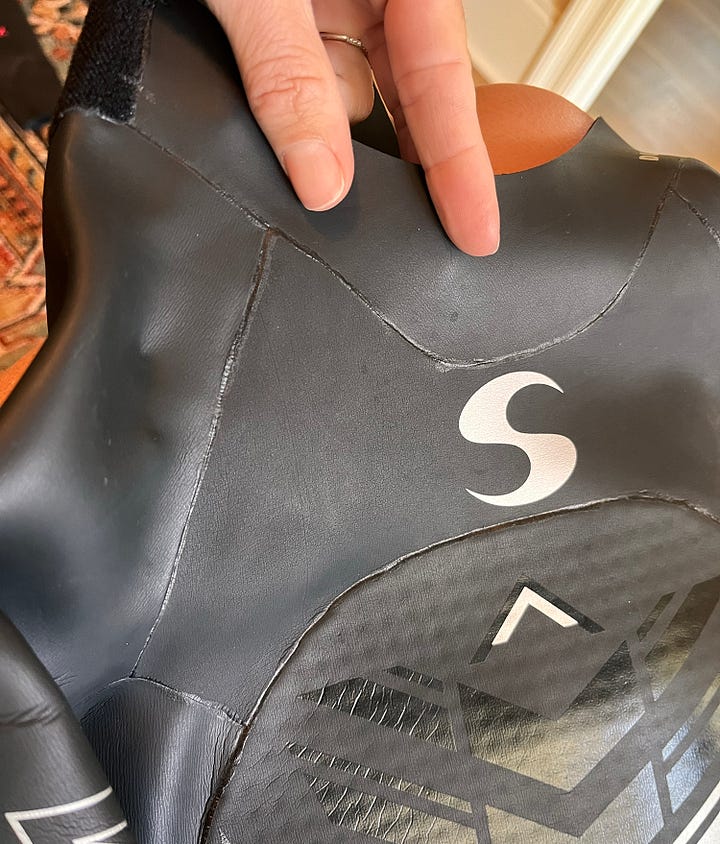
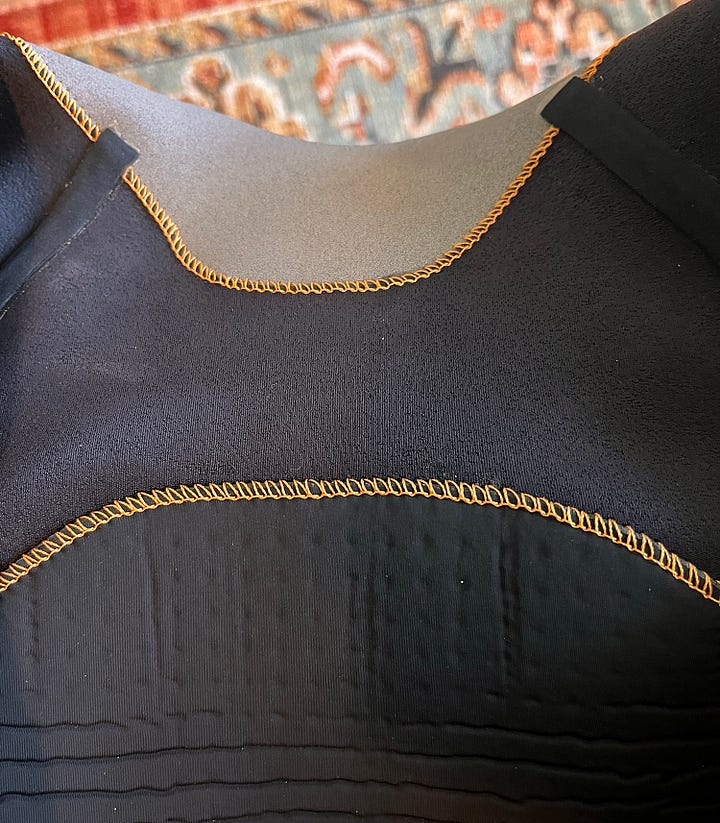
This is essential when putting on this suit in particular, because the max buoyancy panels are a bit more rigid, so you need to make sure they’re in the correct position on the body. I experienced no shoulder restriction in this suit, and it was comfortable to swim in.
I did notice a higher cut on the back of the ankles, which Synergy calls their “T1 extraction panel” which is kind of fun. Another unique feature is a ribbed material on the forearms, which is called the Powermax panel. I assume the bumps help enhance feel for the water.
On the inside of the suit, there’s an info panel that’s printed directly on the neoprene, so you can write your name and phone number inside. This might be helpful if you leave it behind at a race.

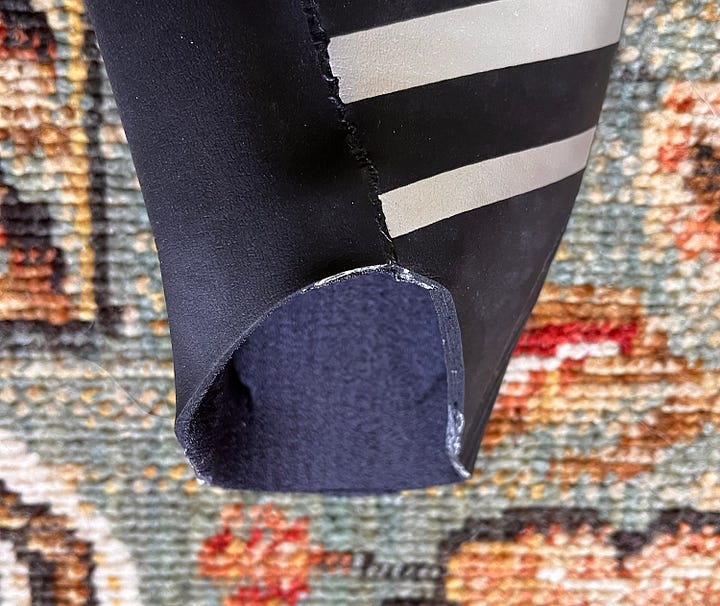
The not-so-great
Because this wetsuit is made of a slightly thicker material in the body and centerline, it has less stretch in those areas, which makes it a bit harder to get on.
With any well-fitting wetsuit, it should take 15-20 minutes to put on. It took me all of that time to put on this wetsuit, in addition to a bit of fussing and fiddling to get everything situated in the right spot.
Because this suit has varying levels of neoprene thickness, it’s important to get the bottom of the suit pulled all the way up to the crotch before working on the upper half, so it feels comfortable while swimming.
Oddly enough, this suit was also a bit hard to get off, and I’m not sure why. Typically, wetsuit removal is pretty easy, as the water that seeps inside the suit helps it slip off your arms and legs with just a bit of pressure. However, I struggled to remove this suit for some reason.
Also, I experienced a bit of chafing at the back of the neck. This can happen with wetsuits because of the need to lift your head to sight. The issue is often exacerbated in saltwater. Using Body Glide can help prevent chafing.
Because I took this wetsuit right out of the packaging before swimming, it was folded over. Initially, I thought a crease in the neck material might be the cause of the chafing. But after noticing a similar remark in another review, I think it may have to do with a rough edge at the neckline where two layers of neoprene meet. It might need some DIY trimming to prevent this from happening again.
Price and warranty
For a top-tier triathlon wetsuit, the Synergy Hybrid EFX4 has a more moderate price of $995. Take a look at the prices of comparable high-end models in different brands.
deboer- Fjord 4.0- $1,499.95
ROKA Maverick X3- $1,345
Blueseventy Helix- $975
Zone 3 Vanquish X- $949
Zoot Wikiwiki 3.0- $875
XTERRA Vector Pro- $699
Quintana Roo HYDROsix2- $630
Synergy offers a 2-year warranty on the Hybrid EFX4, but product registration is required. Also, they have a great lifetime replacement program where you can send in a wetsuit at any time and get a replacement discount of 30% off Volution and 40% off Endorphin, Adrenaline, and Hybrid.
*Now, it’s time for your gift!
Synergy has generously given Triple Threat Life subscribers a code for 20% off. It can be used on any Synergy product, including wetsuits, swimskins, tri suits, running apparel, and goggles.
Use code: triplethreat for 20% off Synergy.
(That means $200 off the Hybrid EFX4!)
Bonus mini-review- Trisight Polarized Goggles
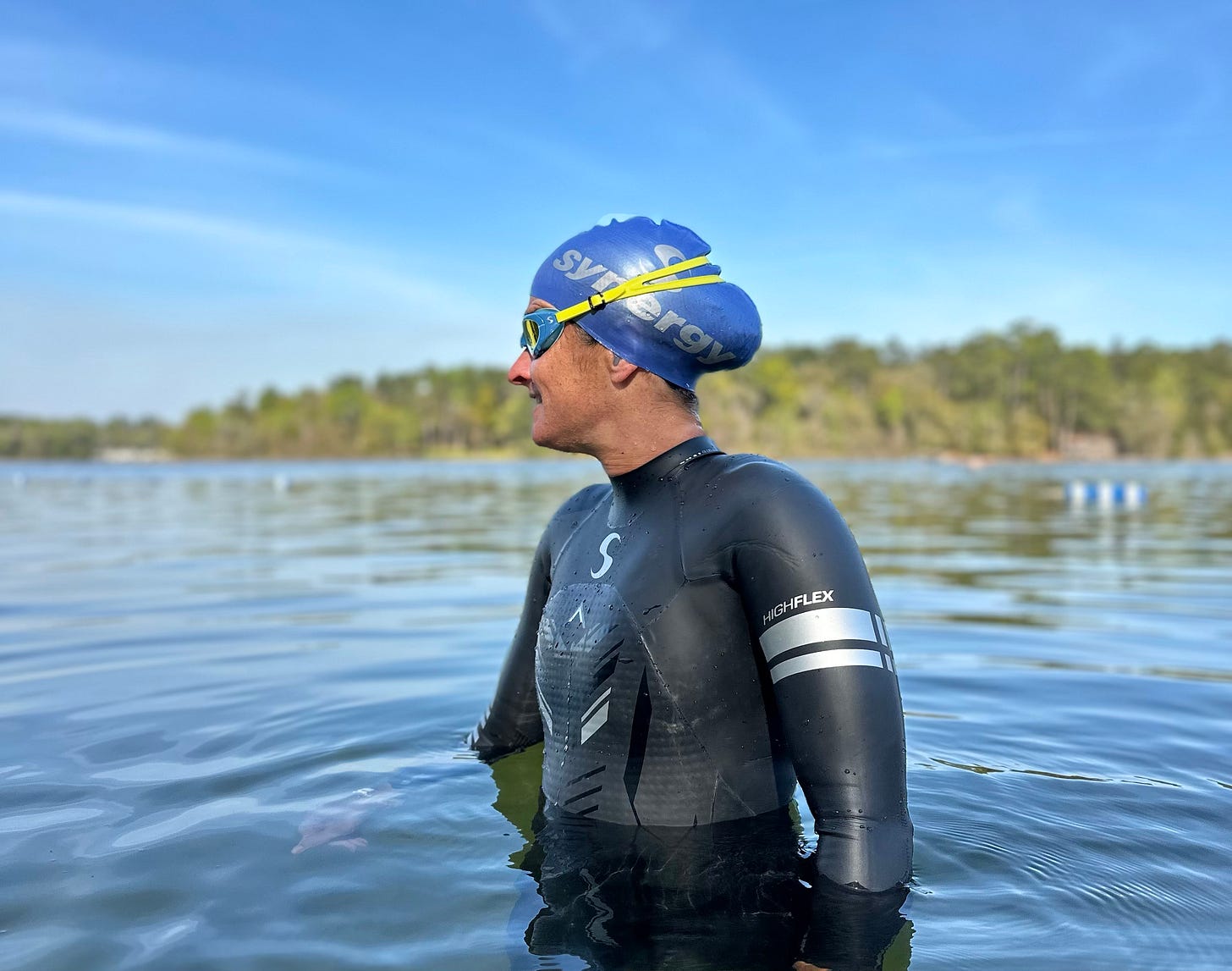
Speaking of goggles, I was excited to see that Synergy included two pairs of goggles and a few swim caps with my wetsuit. Honestly, I didn’t expect much from these Trisight Polarized Goggles, but I was pleasantly surprised!
They have an excellent field of vision and are so comfortable. Also, they’re polarized and have embedded anti-fog, which makes them great for outdoor swims in bright sunlight.
My favorite part is the silicone gaskets that provide a soft, leak-free seal, so no raccoon eyes. Also, I really like the single strap on the back, so I don’t have to fuss with tucking in goggle straps, like with other brands. Also, they’re just $35.
These goggles have definitely found a place in my gear line-up.
Up next, I will be reviewing another wetsuit from Synergy that’s specifically designed for the beginner triathlete- the Hyperion Elite. It’s a new model that supposedly offers “elite level performance at an entry level price point.”
It’s just $395. Stay tuned for that review coming soon.
News & Notes:
I’m doing something a bit different for today’s News & Notes section. As a member of the media, I receive pressers for events, and today IRONMAN released the start list for IRONMAN Texas. It’s the first North-American IM and there’s quite a fun mix of athletes planning to compete. After all, it’s got a $175,000 prize purse and max 5,000 points for the IM Pro Series.
Some of the headliners include the IM TX defending champ Kat Matthews, reigning 70.3 WC, Taylor Knibb, and 2022 IM WC, Chelsea Sodaro. Also, there’s reigning IM WC, Patrick Lange, 2022 IM WC Gustav Iden, and 2021 IM WC, Kristian Blummenfelt.
There’s other impressive athletes like Danielle Lewis, who just placed 3rd at 70.3 Oceanside and new pro Stephanie Clutterbuck, as well as Rudy von Berg, who placed 2nd at 70.3 Oceanside (and needs to answer my email, but I get it he’s been busy), Daniel Bækkegård, Trevor Foley, and Robert Kallin.
But I want to tell you about a few of my personal favorites.
On the ladies side, I’m rooting for Tamara Jewett to have a great race. This will be her first full-distance IRONMAN! She’s a soft-spoken athlete who’s super smart and comes from a regular person background (as a lawyer). I interviewed her for How to Deal with a Penalty Like a Pro.
Another super positive and sweet human being is Alice Alberts (who also reads this newsletter) and is always so accommodating to my numerous interview requests. Good luck Alice! I interviewed Alice for the Master the Course Preview for IRONMAN Texas.
Olivia Dietzel is a newer pro that was on the Spaero elite team with Matt and I. Liv is a firecracker, very hardworking, and maintains proper perspective by always racing with her faith and memory of her dad at the forefront of her mind.
Also, Haley Chura is just a bright light and colorful personality who doesn’t take herself too seriously. She gives great, practical advice as well. I think about how she told me once that she will never let anyone “hijack” her long runs, meaning she will run it as slow and easy as she needs to, regardless of perceptions about pace. I think about that often during my long runs. I interviewed Haley for my IRONMAN blog leading up to my first full distance race.
For the guys, Matt Hanson is always willing to give great advice. I interviewed him for the IM Texas Course Preview as well. He’s a savvy competitor and a “technical smarts” athlete. I remember how he said the first lap of the run is about holding back and taking in as much nutrition as you can. The second lap is about holding form and staying cool. And the third lap “is where you go to war and decide how bad you’re willing to hurt to go after your goals.”
I’m rooting for Gustav Iden to have a great race, because he seems like his personal life and mental health outside of triathlon is in a much better place this year.
Leon Chevalier is very approachable, kind, and always concludes his emails with a French sign-off, which is fun.
Matthew Marquardt is one of our favorites. He’s pulling double-duty as a top-level pro and he’s in medical school, which is literally insane. He was our guest speaker in February and was so kind to answer athletes’ questions.
There’s also Ben Kanute, Mr. USA and a family man. He helped me out with this Best Bike Fitters in the US piece.
Also, Cam Wurf is super funny, has a chill personality, and how he’s both a World Tour cyclist and a triathlete is beyond me.
Finally, best of luck to our friend and former Spaero elite teammate, Matt Jackson, who will be doing his first IRONMAN as a pro (although he’s done 13 as an age-grouper.) Good luck “other Matt!”
Also, best of luck to Tara Manson Calkins, former Spaero elite buddy and mom who’s doing her 4th Ironman. Here’s to hoping the taper crankies have abated and you have your double plastic bag system ready. ;)
If you enjoyed this edition of Triple Threat Life, consider becoming a paid subscriber.
Or you can share this newsletter with someone who might benefit from reading it!





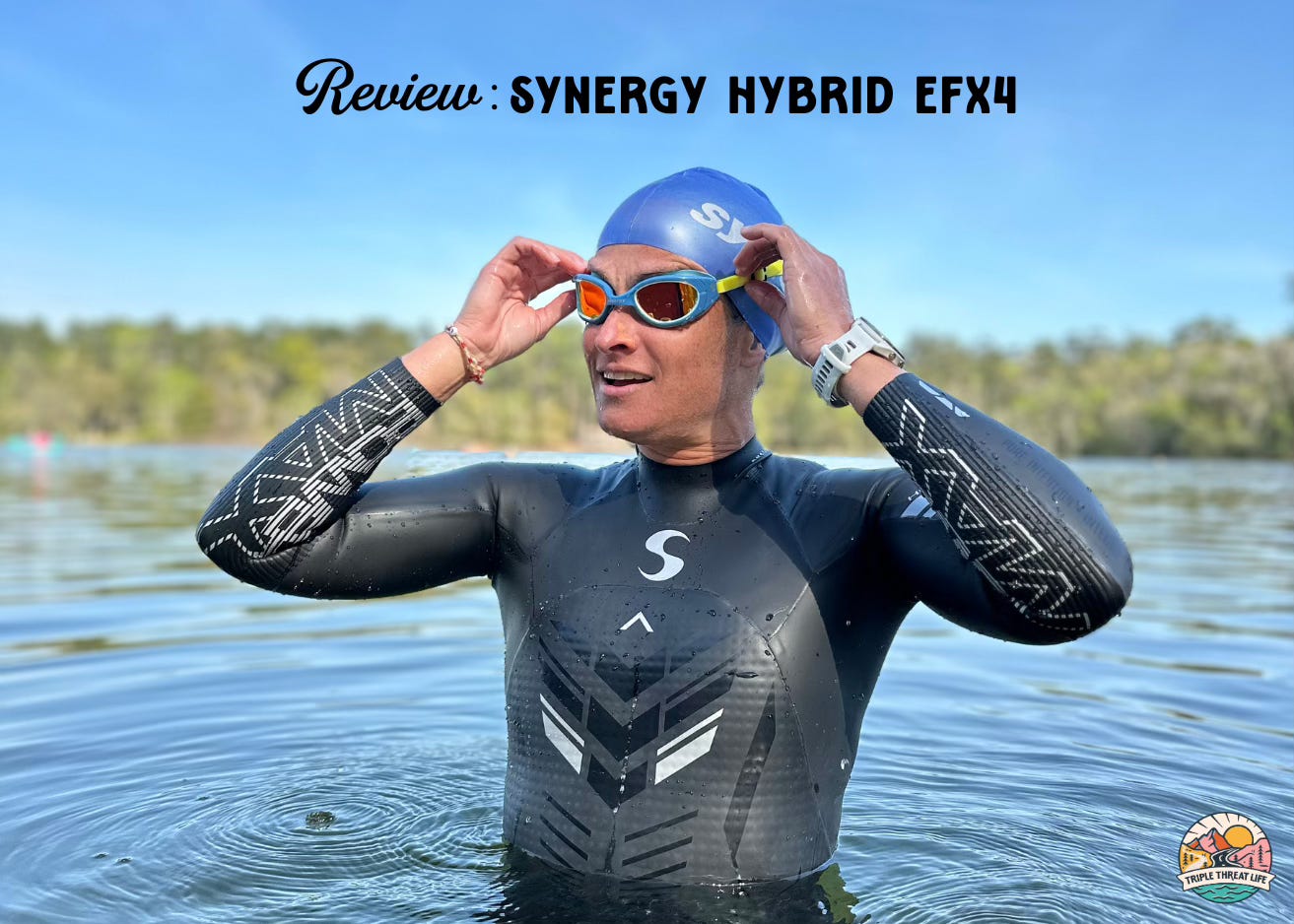

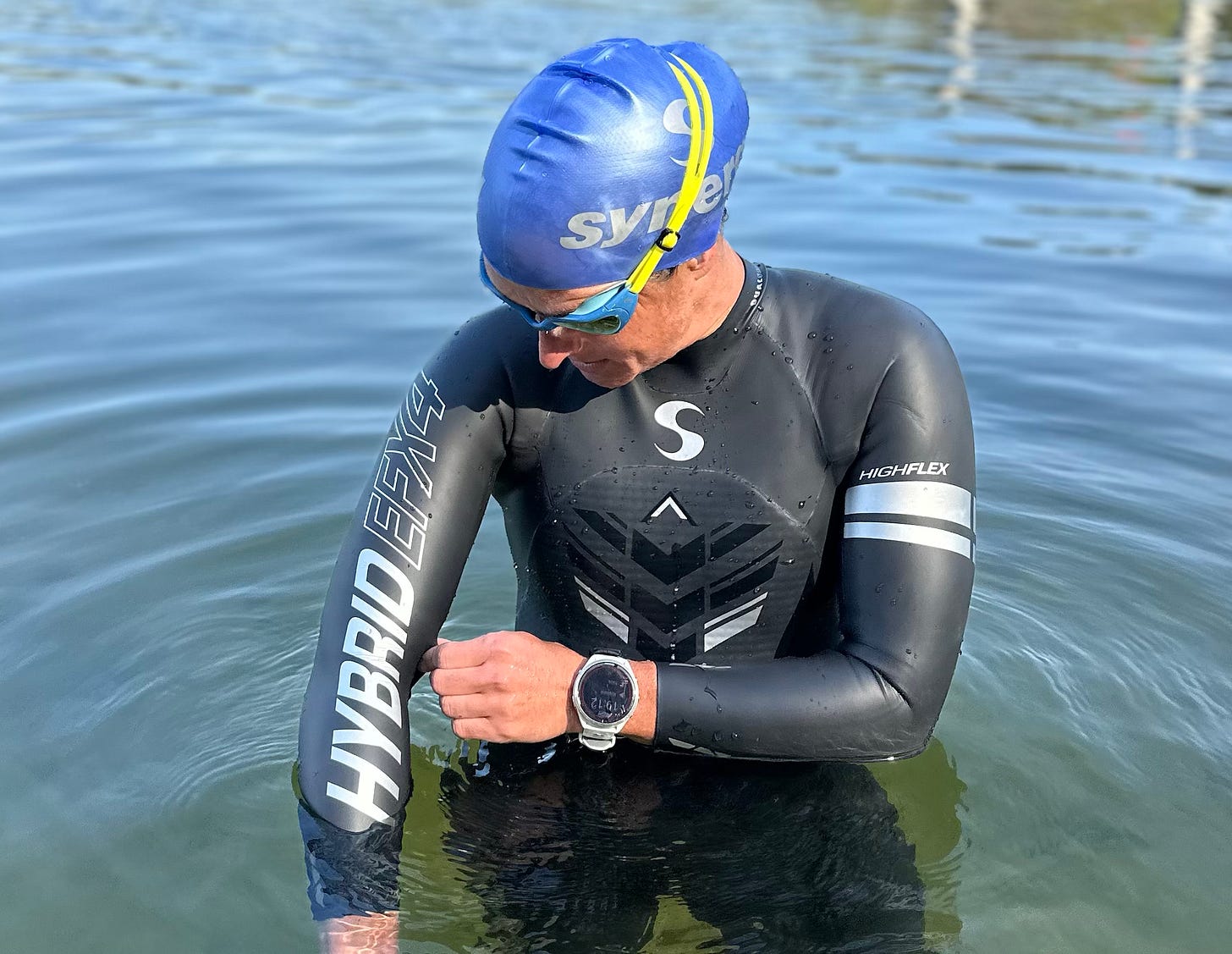
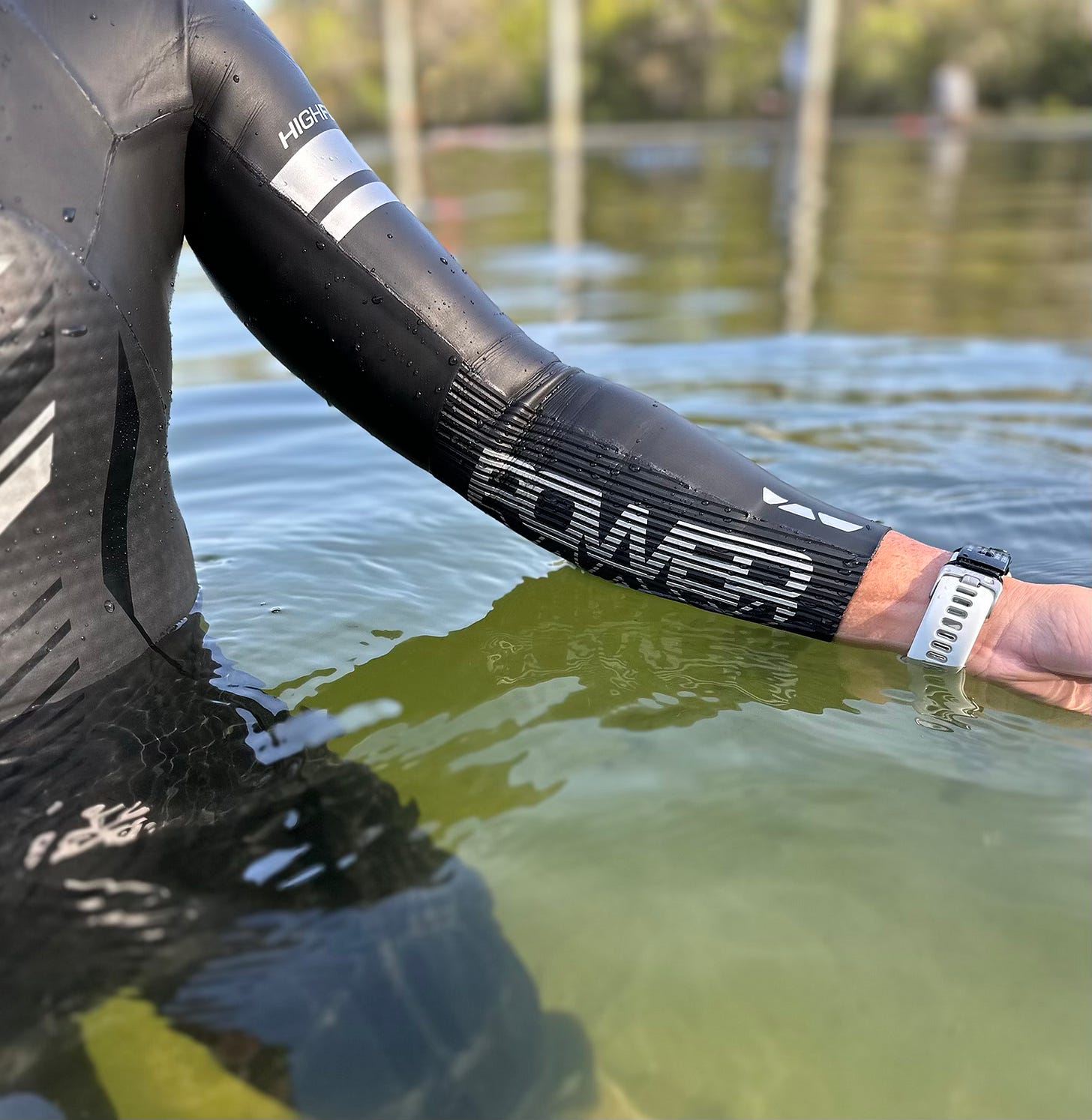


Hey! Thank you so much for the very detailed review! I wanted to buy one with the code but it's not working. Is it too late?